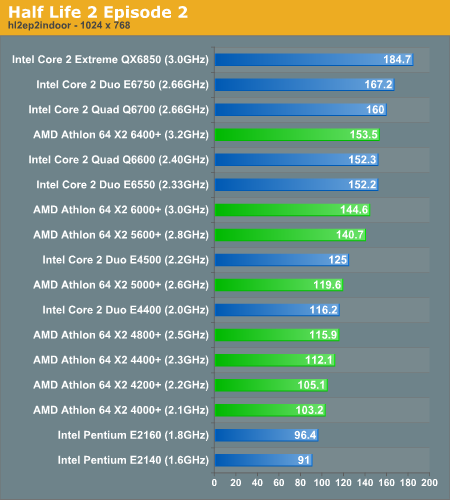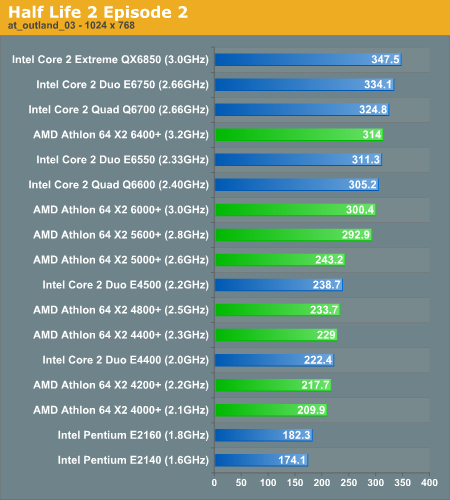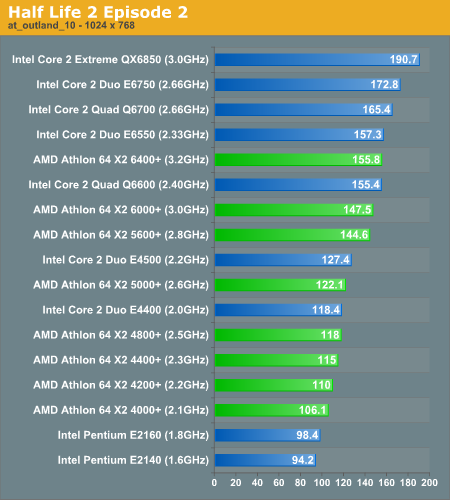UPDATED Half-Life 2: Episode 2 CPU and Graphics Performance
by Anand Lal Shimpi & Derek Wilson on October 12, 2007 7:00 AM EST- Posted in
- GPUs
The Benchmarks
We ran all of our tests on the following system configurations:
We'll start off with a look at CPU performance. For these tests we ran at 1024 x 768 to minimize any GPU bottlenecks and highlight differences between CPUs.
CPU Performance
Our first benchmark is of an indoor map with a reasonable sized firefight taking place. The frame rates are high due to the indoor environment but the explosions and computer interaction keep our CPUs busy doing more than just feeding data to the GPU.

Intel continues to hold onto the overall performance crown as AMD has nothing faster than the Athlon 64 X2 6400+, but the race is a bit closer at lower price points.
The limited production 6400+, albeit more expensive than Intel's Core 2 Duo E6750, ends up underperforming its closest competitor. The Core 2 Duo E6550 is about 5% faster than the Athlon 64 X2 6000+, but honestly the performance advantage isn't large enough to really matter, especially in more realistic GPU-bound scenarios.
The Core 2 Duo E4000 series ends up losing a bit of ground to AMD thanks to having a smaller L2 cache and slower FSB, both of which Episode 2 is particularly sensitive to. The Athlon 64 X2 5600+ is 12% faster than its price-competitor, the Core 2 Duo E4500. It's interesting to note the impact of L2 cache size on performance even in the AMD camp; the Athlon 64 X2 5000+ only has a 512KB L2 per core (vs. 1MB of the 5600+) and performance drops significantly, to the point where it's a toss up between the 5000+ and the Core 2 E4400.
At the low end of the spectrum, Half Life 2's dependency on very fast memory accesses and large cache sizes really penalize the Pentium Dual-Core processors, both of which are bested by their AMD rivals. AMD's margin of victory isn't tremendous but it's clear that Intel's lack of an on-die memory controller does hinder gaming performance of these small-cache parts.
Look at real world performance however, even the difference between an Athlon 64 X2 4200+ and a Pentium E2160 will be largely masked by GPU limitations at higher resolutions.
Our next benchmark takes place in the outland_03 level, in a small indoor environment resulting in ridiculously high frame rates for all of the CPUs. The performance comparison in this benchmark is almost purely academic, simply highlighting differences between microprocessors as even the cheapest CPUs in this comparison pull over 170 fps in this test.

Half Life 2 Episode 2 continues to be very sensitive to FSB frequency, which is part of the reason why we see the dual core E6750 (1333MHz FSB) pull ahead of the quad core Q6700 (1066MHz FSB). There's slight overhead associated with running HL2 on a quad-core system, which doesn't make for a better situation, not to mention that the game doesn't take advantage of more than two threads. Quad-core owners won't really be plagued by lower performance than their dual core compatriots, but they simply don't get any benefit out of the latest version of Valve's Source engine. The standings remain relatively unchanged, once more we see that L2 cache size and latency strongly impact performance. The 90nm Athlon 64 X2 5600+ features a 1MB L2 cache per core with a slightly lower access latency than the 65nm Athlon 65 X2 5000+, with its 512KB L2 per core, the resulting performance difference is significant; the 5600+ holds onto a 20% performance advantage over the 5000+, despite only a 7.6% increase in clock speed.
Intel's Core 2 lineup gets hurt even worse as you look at the 800MHz FSB/2MB L2 E4000 parts. The E4500 is seriously outperformed by the 5600+ and ends up being equal to the 5000+, despite the latter being priced lower.
The Pentium Dual-Core processors pull up the rear once more, thanks to even lower clock speeds and meager 1MB L2 caches shared between two cores.
Our final performance test takes place in the outland_10 map, an outdoor environment where we spend most of our time driving around (poorly) and avoiding the topography of the level.

The standings remain unchanged: Intel holds the overall performance crown, the two are competitive at $150 - $200 price points, and AMD manages to pull ahead in the sub $150 market.
We ran all of our tests on the following system configurations:
| Test Setup | |
| CPU | Core 2 Duo E6550 (2.33GHz 4MB 1333FSB) Core 2 Duo E4500 (2.2GHz 2MB 800FSB) Core 2 Duo E4400 (2.0GHz 2MB 800FSB) Pentium E2160 (1.8GHz 1MB 800FSB) Pentium E2140 (1.6GHz 1MB 800FSB) AMD Athlon X2 5000+ (2.6GHz 2x512K) AMD Athlon X2 4800+ (2.5GHz 2x512K) AMD Athlon X2 4200+ (2.2GHz 2x512K) AMD Athlon X2 4000+ (2.1GHz 2x512K) |
| Motherboard | Intel: ASUS P5K-V G33 AMD: Biostar TF-7050M2 |
| Video Cards | AMD Radeon HD 2900 XT AMD Radeon HD 2600 XT AMD Radeon HD 2600 Pro AMD Radeon HD 2400 XT NVIDIA GeForce 8800 Ultra NVIDIA GeForce 8800 GTX NVIDIA GeForce 8800 GTS 320MB NVIDIA GeForce 8600 GTS NVIDIA GeForce 8600 GT |
| Video Drivers | AMD: Catalyst 7.10 NVIDIA: 163.69 |
| Hard Drive | Seagate 7200.9 300GB 8MB 7200RPM |
| RAM | 2x1GB Corsair XMS2 PC2-6400 4-4-4-12 |
| Operating System | Windows Vista Ultimate 32-bit |
We'll start off with a look at CPU performance. For these tests we ran at 1024 x 768 to minimize any GPU bottlenecks and highlight differences between CPUs.
CPU Performance
Our first benchmark is of an indoor map with a reasonable sized firefight taking place. The frame rates are high due to the indoor environment but the explosions and computer interaction keep our CPUs busy doing more than just feeding data to the GPU.

Intel continues to hold onto the overall performance crown as AMD has nothing faster than the Athlon 64 X2 6400+, but the race is a bit closer at lower price points.
The limited production 6400+, albeit more expensive than Intel's Core 2 Duo E6750, ends up underperforming its closest competitor. The Core 2 Duo E6550 is about 5% faster than the Athlon 64 X2 6000+, but honestly the performance advantage isn't large enough to really matter, especially in more realistic GPU-bound scenarios.
The Core 2 Duo E4000 series ends up losing a bit of ground to AMD thanks to having a smaller L2 cache and slower FSB, both of which Episode 2 is particularly sensitive to. The Athlon 64 X2 5600+ is 12% faster than its price-competitor, the Core 2 Duo E4500. It's interesting to note the impact of L2 cache size on performance even in the AMD camp; the Athlon 64 X2 5000+ only has a 512KB L2 per core (vs. 1MB of the 5600+) and performance drops significantly, to the point where it's a toss up between the 5000+ and the Core 2 E4400.
At the low end of the spectrum, Half Life 2's dependency on very fast memory accesses and large cache sizes really penalize the Pentium Dual-Core processors, both of which are bested by their AMD rivals. AMD's margin of victory isn't tremendous but it's clear that Intel's lack of an on-die memory controller does hinder gaming performance of these small-cache parts.
Look at real world performance however, even the difference between an Athlon 64 X2 4200+ and a Pentium E2160 will be largely masked by GPU limitations at higher resolutions.
Our next benchmark takes place in the outland_03 level, in a small indoor environment resulting in ridiculously high frame rates for all of the CPUs. The performance comparison in this benchmark is almost purely academic, simply highlighting differences between microprocessors as even the cheapest CPUs in this comparison pull over 170 fps in this test.

Half Life 2 Episode 2 continues to be very sensitive to FSB frequency, which is part of the reason why we see the dual core E6750 (1333MHz FSB) pull ahead of the quad core Q6700 (1066MHz FSB). There's slight overhead associated with running HL2 on a quad-core system, which doesn't make for a better situation, not to mention that the game doesn't take advantage of more than two threads. Quad-core owners won't really be plagued by lower performance than their dual core compatriots, but they simply don't get any benefit out of the latest version of Valve's Source engine. The standings remain relatively unchanged, once more we see that L2 cache size and latency strongly impact performance. The 90nm Athlon 64 X2 5600+ features a 1MB L2 cache per core with a slightly lower access latency than the 65nm Athlon 65 X2 5000+, with its 512KB L2 per core, the resulting performance difference is significant; the 5600+ holds onto a 20% performance advantage over the 5000+, despite only a 7.6% increase in clock speed.
Intel's Core 2 lineup gets hurt even worse as you look at the 800MHz FSB/2MB L2 E4000 parts. The E4500 is seriously outperformed by the 5600+ and ends up being equal to the 5000+, despite the latter being priced lower.
The Pentium Dual-Core processors pull up the rear once more, thanks to even lower clock speeds and meager 1MB L2 caches shared between two cores.
Our final performance test takes place in the outland_10 map, an outdoor environment where we spend most of our time driving around (poorly) and avoiding the topography of the level.

The standings remain unchanged: Intel holds the overall performance crown, the two are competitive at $150 - $200 price points, and AMD manages to pull ahead in the sub $150 market.










46 Comments
View All Comments
retrospooty - Saturday, October 13, 2007 - link
I have never had an issue with steam, using it since HL2 first came out. Not sure what your issues are, but you might want to look into them.RamarC - Friday, October 12, 2007 - link
what a twit. hundreds of thousands of satisfied users, but he can't get it to work so it must be a piece of crap. go play your ds... even six year olds can handle those.cmdrdredd - Friday, October 12, 2007 - link
You're just a moron then. Steam works fine, the game is fine, Valve did a good job.Everyone knows that the HD2900XT does pretty poorly at high resolutions with AA. Every game is like this. To be surprised means you weren't paying attention
redfirebird15 - Friday, October 12, 2007 - link
Can you post screenshots comparing the AA enabled to the non-AA enabled tests? Just wondering if the increase image quality compares with the impact on performance. Thanks!Oh and could you post results for a 1900xtx? It may be older but the cost of upgrading hasn't been justified yet.
shabby - Friday, October 12, 2007 - link
Wow that 2900xt just tanks when you enable aa, bummer.Spartan Niner - Tuesday, October 16, 2007 - link
Last time I checked, the 2900XT doesn't scale as nicely with AA as 8800 series cards do. Also, the resolutions tested and the cards used in this comparison are far from what mainstream gamers use... the CPU comparisons are also nice but shouldn't be the main focus. The results basically tell us more expensive CPUs give better stock performance...At the very least, a test utilizing more common resolutions 1600x1200, 1280x1024, 1024x768 for 4:3 and resolutions such as 1680x1050 and 1440x900 for the widescreen crowd combined with the usage of X1xxx-series ATI cards and 7xxx nVidia cards would be more realistic.
For reference, I use a E2140 @ 2.4GHz and an X850 XT video card and run CS/DOD Source at max everything, 4xAA. At least for my needs it seems like any video card short of a 8800 series card or a 2900 series card is not a cost-effective upgrade when mid-range cards don't offer that much of a performance boost over my X850...